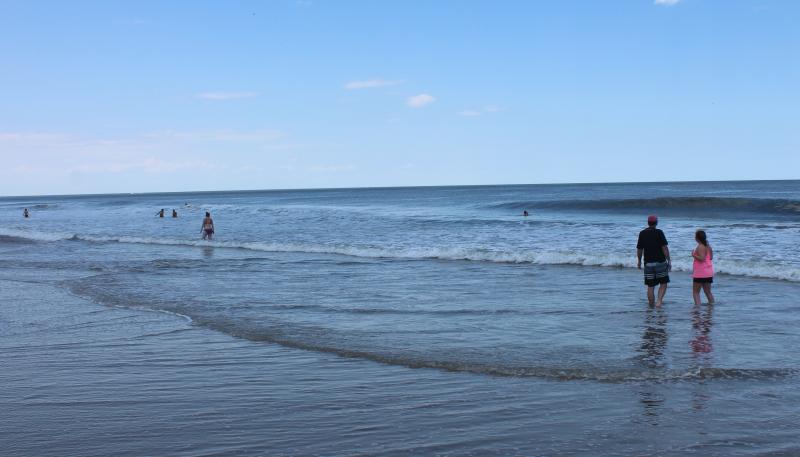Rehoboth wastewater outfall up and running
After years of bureaucratic delays and months of construction, the Rehoboth Beach wastewater treatment plant is pumping its treated effluent into the ocean through an outfall more than a mile off Deauville Beach.
Rehoboth City Manager Sharon Lynn announced the project was up and running during her city manager’s report at a city commissioners workshop June 4. She said testing had been completed, and as of May 30, the outfall had been sealed, and the pump station was working correctly.
“What I just explained is a huge milestone,” she said. “The ocean outfall is now running and successfully working.”
Getting to the point where the outfall was up and running was years in the making.
The city was originally issued a court order to stop dumping its treated effluent into the Lewes-Rehoboth Canal by the end of 2014. However, it was given an extension to June 2018 after the state dragged its feet in making a decision on whether to approve the outfall.
At the beginning of the process, the city looked at other disposal methods, including land application, but ultimately decided on ocean outfall as the most cost-effective solution.
In June 2015, Rehoboth voters approved a referendum to spend $52.5 million on the project, which included $25 million for the outfall pipe, $10 million for upgrades to the wastewater treatment plant, and $12.5 million for an upgraded biosolids treatment facility.
In May 2017, Delaware Department of Natural Resources and Environmental Control Secretary Shawn Garvin issued an order approving the outfall.
In a June 6 email, Mayor Paul Kuhns said it feels great to have the project up and running. He said with the exception of the difficult weather patterns of this winter and spring, the construction went as planned, and he was happy to meet the June 1 deadline.
“We were very fortunate to work with DNREC and the Army Corps, and secure permit extensions to cover the delays,” said Kuhns.
Kuhns said the pipe runs more than 6,000 feet out into the ocean, at a depth of 40 to 50 feet below the surface of the water. He said at the end of the pipe is a giant diffuser with a substantial number of tentacles that spread the water in many directions.
“Finally, given the turbulent nature of the water currents in that area of the ocean, the treated effluent is flushed constantly by the continuous ocean flows,” he said. “We are extremely happy to be out of the canal and therefore contributing to the environmental improvement of the Inland Bays.”
In an interview June 6, Lynn said, overall, the project doubles the plant’s flow capacity from 3.5 million gallons per day to 7 million gallons per day. Those are peak summer season numbers, she said.
“Midwinter, there could be less than 2 million gallons per day,” she said.
Beachgoer reaction to outfall
Reaction from a handful of beachgoers at Deauville Beach on a sunny day mid-week was mixed. Not one person knew the outfall was up and running, and only some visitors from Kent County were even aware of the project.
Nathan Turock of Scranton, Pa., was quick to say he thought it was ridiculous the city was pumping its wastewater into the ocean. He said he didn’t like the idea of the ocean being pumped full of all the chemicals being used to treat the water.
“They should stop it immediately,” he said.
Turock said he would have pushed for using the spray irrigation method. That way, the ground can naturally filter out chemicals, he said. Turock was the only one who was adamantly against the outfall.
Terry Jaywork, who lives in Camden and owns a place in Rehoboth, said he was confident that DNREC wouldn’t have approved the outfall permit if it wasn’t safe for the effluent to be pumped into the ocean.
Mostly, people had more questions.
Standing knee-deep in the water directly between the diffuser and the beach, Chris Rogan of Virginia was surprised to hear of the outfall, but he didn’t rush to judgment. He said he didn’t know enough about the project to have an opinion, but he knew something had to be done with the waste.
Another woman, who declined to identified, said she didn’t like the sound of the outfall, but like Rogan, she had more questions than anything else.
Still some work to be done
As part of her city manager’s report, Lynn said there was still some work related to the outfall left to be done.
Henlopen Avenue was in the process of being milled down and paved, which Lynn anticipated would take two weeks to complete. She said the stone shoulder will be installed on both sides of the road followed by the top coat of paving.
Lynn said paving on Canal Street will follow Henlopen Avenue. Both roadways were dug up during the outfall pipe construction process. The contractor working hours on Henlopen Avenue will be 6:30 a.m. to 6:30 p.m., and Canal Street 8 a.m. to 5 p.m.
Lynn also said the roof for the pump station was in the process of being redone.
Ribbon cutting for outfall
To celebrate the completion of the outfall project, the city has scheduled a ribbon cutting for 11 a.m., Friday, June 15, in the Deauville Beach parking lot.
In addition to Kuhns, U.S. Sen. Tom Carper, Center for the Inland Bays Executive Director Chris Bason, and DNREC Division of Watershed Stewardship Director Terry Deputy are expected to say a few words.
Chris Flood has been working for the Cape Gazette since early 2014. He currently covers Rehoboth Beach and Henlopen Acres, but has also covered Dewey Beach and the state government. He covers environmental stories, business stories and random stories on subjects he finds interesting, and he also writes a column called Choppin’ Wood that runs every other week. He’s a graduate of the University of Maine and the Landing School of Boat Building & Design.




















































